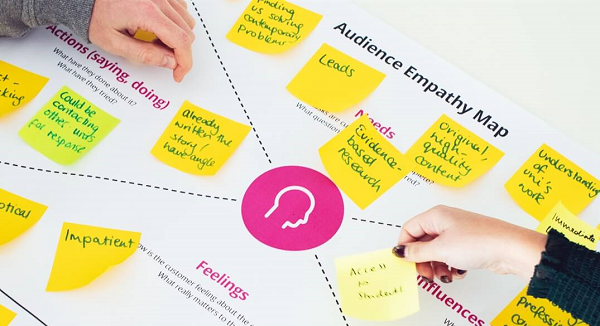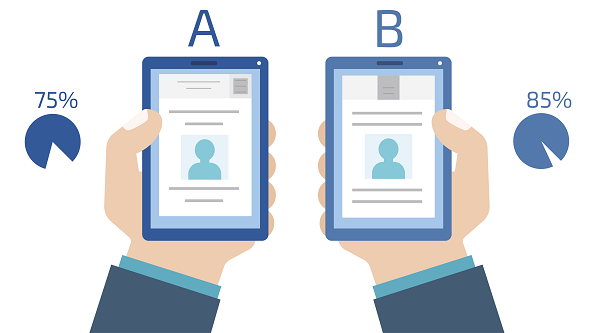Pivoting your online business for changing customer needs

By Luke Hay|26 Mar 2020
The needs of your customers, audience or users should be at the forefront of your mind when building and updating your online offering. And in these uncertain and constantly changing times, being in tune with your customers and their needs is essential. With most physical buildings closed, it is more vital than ever that your website and online marketing work hard to bring in business.
You’ll no doubt have seen the effects of Covid-19 on your business already. While it will impact every business differently, your actions at this stage will shape how the next few months pan out for you from a digital perspective. This article will not focus on any one sector or industry, but will instead look at some of the likely changes to customer needs, and how to best react to them.
Have your marketing questions answered by us on our Fresh Thinking Live! webinar
Changing customer needs
From a physical point of view, your customers are more likely to be working from home and potentially spending almost all of their time in their homes. They may be looking after their children full-time or may be self-isolating on their own. They may also have responsibilities for looking after others, such as their elderly parents, remotely.
Financially speaking, people are likely to be more cautious and the impact of Covid-19 has already led to job losses and cash-flow issues. This may mean that they have to cut back and be more careful with their money. On the other hand, panic buying of certain products has demonstrated the immediate impact of the pandemic on shopping behaviours and needs.

From a psychological point of view, at times of uncertainty people will be looking for trust, reassurance and security. They need clearer messaging, secure and safe services and the feeling that the companies they are dealing with, care about them and their needs.
When buying physical products online, customer needs around delivery and customer service are more important than ever. Customers will want information about how long deliveries will take, as well as reassurance around returns and answers to post-purchase product questions.
The needs of your customers will have changed dramatically over the past days and weeks, and you need to ensure you understand what those changes mean for your business. While you’re likely to have some good insight into these evolving needs, it’s important that your thoughts are collated and documented, and that further research is undertaken to challenge and validate your thoughts.
When buying physical products online, customer needs around delivery and customer service are more important than ever. Customers will want information about how long deliveries will take, as well as reassurance around returns and answers to post-purchase product questions.
Luke Hay, User Research Director - Fresh Egg
Understanding customer needs
The needs of your customers are likely to be changing on a daily basis at the moment. People are reacting to developments and government advice, as well as to the availability of products. The following areas are recommended to better understand changes in their needs and priorities.
Website data analysis
Google Analytics and similar tools hold a wealth of information around how user behaviour and needs have changed. While analytics data won’t tell you why behaviour has changed, it will show what has changed.
Looking at data prior to key announcements on the spread of Covid-19 and comparing it to behaviour since will help highlight changes in behaviour. Using analytics data along with heat-mapping data from tools like Hotjar will enable you to drill down into more detail on what your customers are doing differently.
Session recordings should also be viewed in order to see behaviour on an individual user basis. This is time consuming but can give great insight into what’s happening.
When analysing this type of data, remember not to treat ‘customers’ as one generic group. Break them down by device type, time of day and, perhaps most importantly, by country. As different countries react in different ways, it is important to be sensitive to customer needs based on their location.
It’s worth using the annotations feature within Google Analytics to record any external factors plus any changes that you make in your marketing activity.
Empathy/journey mapping and personas
It is likely that you will have a strong idea of what your customers are going through. You know your customers well and are likely to have already had several discussions within your business about how the current situation will affect them.
One way to collate and document these thoughts is by creating empathy maps. This will help you to capture all the important needs of your customers in one place, as well as listing their goals and pain points. Our guide to empathy mapping will help you get started. Journey mapping may also be helpful at this point.

We have moved our empathy mapping workshops online, so if you would like one please get in touch. If you already have completed empathy maps, create new ones to accommodate changing needs.
Some of you will also already have personas of your key customers. If this is the case, you should update them to create temporary new personas based on the current situation.
User testing
In order to validate and challenge your thoughts on customers and their behaviour, and to find out the ‘why’ behind the ‘what’ that you uncover through analytics, you may want to run testing with real people.
In the current climate, in-person user testing is not advisable. It is however a good time to run remote user testing. Your customers are likely to be based at home and may have additional time on their hands. Why not run some testing to find out how they are using your website? You can also use the opportunity to ask them questions about how the current situation has changed their needs, and what they look for from companies like yours.
If you want some tips on user testing, read our guide to user testing, and get in touch if you want us to help run user testing on your website.
On-site surveys
Asking customers how the current situation has impacted them will help you better understand their needs. While it is important not to take the results from surveys like this as gospel, they can be helpful in giving insight into what your customers are going through.
Quick pop-up questions on your website could be used to find out specific information, e.g. ‘Did you find what you were looking for today?’ or used to ask broader questions around how the current situation has changed their attitude towards your product or service.
Attitudes are changing quickly and surveys will improve your awareness of those changing needs.The results can help to shape your next steps and ensure that you are making informed decisions that lead to impactful results.
These survey questions can be set up and run quickly using affordable voice of customer tools. Talk to us to find out how we can help you use on-site surveys to inform your decisions.
Social media monitoring
It is likely that your customers will be communicating their thoughts on social media at this time. Studies have revealed large increases in usage of most forms of social media in recent weeks as people reach out to each other online due to self isolation, social distancing and an increased need to find and share information. This means that there is lots of data you can analyse in order to see how you can help meet customer needs and solve their problems.
A first step would be to understand how people are talking in relation to your sector - are they saying different things or asking different questions to normal?
You can also look to see how other brands are engaging with this, for example if they have upped their game and started to become more vocal on social channels.
Search intent
During the last two weeks search engine usage has increased dramatically. And it isn’t just the volume of searches that has changed, but also the sorts of things people are typing into Google.
Carrying out search intent research within your sector will allow you to understand not only what people are searching for, but also which websites are currently getting their attention.
By understanding the changing needs of people when searching will allow you to create the right content that will engage with them and also tweak your messaging to resonate better.
A/B testing
With a better understanding of changes to customer needs, you will have some ideas on what should be altered on your website. These ideas can be tested using A/B testing where possible. This will ensure that you can track the results of changes to ensure that they are having the desired impact.

For various reasons it may not always be practical, or possible, to A/B test changes.For example you may not have access to the required development resource. In this situation A/B testing tools can be used to make quick changes to websites. They can be particularly useful if development resources are limited.
If you’d like to test changes to your website, contact us about our A/B testing services.
All of the user research methods above can all be completed within days rather than weeks so will be able to give you real, actionable insights into your customers’ behaviour in time to be able to act on.
All of the user research methods above can all be completed within days rather than weeks so will be able to give you real, actionable insights into your customers’ behaviour in time to be able to act on.
Luke Hay, User Research Director - Fresh Egg
What you can do
Once you have a better idea of current customer needs you should act quickly to ensure that your online offering meets those needs.
Communication and trust
The first thing to ensure is that you are mindful of how you communicate with your customers. Clear communication is key, and you need to be considerate and aware of the situation as it evolves. At this time your focus should be on building trust and ensuring that your customers feel safe and secure using your service or buying your products.
You also need to make sure that you are available to your customers and, where possible, you are able to be flexible to meet their needs. Customer service is particularly important when trying to meet the needs of stressed and anxious people.
Changes to services
Where possible you may need to update areas of your service. It may be that you use this opportunity to offer full online ordering for the first time. Or, if you’re already a thriving e-commerce business, you may need to look at your delivery options; is it possible to offer ‘no contact’ delivery, for example? Delivery timings and methods may need to be reviewed too.
The messaging around how you deliver goods or services may need updating. It comes back to the trust issue. You need to ensure that good cleanliness and hygiene is followed and promoted at this time.
Online changes
If you’re already running a successful website, small changes like changing the order that products are displayed on a page can make big differences. Ensure that the products or services that people need most at this time are prioritised.
Now may be the time to help your customers by addressing any issues on your backlog, such as improvements to your search functionality.
If appropriate, you should also make sure that you’re including clear and reassuring messaging about how you are reacting to Covid-19 within your business.
You may want to offer discounts where appropriate and improved guarantees of service levels. This will depend on your type of business, and is another reason why user research is vital to understand what you need to do to meet customer needs.

Finally, as mentioned in the first point you’ll want to work towards building trust through your website. Trust signals are more important than ever in these uncertain times. These could include using testimonials from customers or show your review ratings from third-party review sites (such as Trustpilot).
Partnering with other companies
There is currently a message around ‘community’ being pushed and this could extend to business as well. There is an opportunity for you to consider whether there are other businesses that you might be able to partner with for mutual benefit. For example, you might well have a product or service that another business has the perfect audience for - a partnership would help you to reach that audience.
Naturally you need to consider GDPR within this and can’t share user data with third parties, but there are lots of different tactics you can employ to promote your partners’ messages and content, for example discounted offers via email or joint social media competitions.
There may also be opportunities for you to investigate partnering with others on more practical levels, for example offering a joint service or even sharing staff who can provide what both of your businesses need.
Offering to help and showing support
Some companies are already being highlighted as being part of the problem or part of the solution when it comes to how they are reacting to the current situation. It is important that you offer help to people in need where you can, and support those working hard at these difficult times.
Doing something to help essential workers, e.g. offering discounts for NHS staff, is one way to show your support.
If your company is qualified to do so, you should offer advice on how your products and services can help, or more general advice on how people can cope in the current situation. This may be mental or physical health tips, or even setting up quizzes, video series or games to help keep people occupied.
If you’re a charity, now is the time to use ‘help us to help others’ style messaging. People will naturally want to help during this time so make it clear how donating to your charity can help in the current situation.
In short, be aware of people’s physical and mental health, and do what you can to help.
People are still buying
In the short term, people are likely to be cautious about spending money. However, people still need to try to keep some sense of normality. There is an opportunity to help people to feel ‘normal’ by providing products or services that help with this.
A lot more people are now working from home and are likely to have more time on their hands. This may give them more time to take up hobbies or spend time learning online. Others may take on DIY projects or look into other pursuits that they’ve been putting off.
You may want to shift how you promote your products to better fit the situation that most people now find themselves in. This may involve changing product images to show people using products in their homes rather than outside.
People may also want to treat themselves at a time like this to keep their spirits up, as a form of retail therapy. In a fast changing and high-paced environment, you’ll need a way to stand out. Offer something different from your competitors and ensure that you don’t get lost in the rush to win more business.
In summary
Whether you’re looking to change your marketing communications or optimise your website layout, be considerate of the current situation and aim to help rather than to take advantage. Be aware that your customers will be more likely to be stressed and anxious and they are likely to be bombarded with hundreds of different marketing messages. Treat them with respect, give them what they want and gain their trust.
What next?
We hope this post has been useful and given you some ideas. At Fresh Egg, we believe if we all work together we can get through the current crisis successfully.
If you want our help, please get in touch as we want to support businesses like yours through these challenging times. Contact the Fresh Egg team by email hello@freshegg.com or call us on 01903 285900.
Keep learning with Fresh Egg
Join our email list like thousands of other marketing professionals to get updates on key industry changes, early access to free resources and exclusive invitations to Fresh Egg events in your inbox.